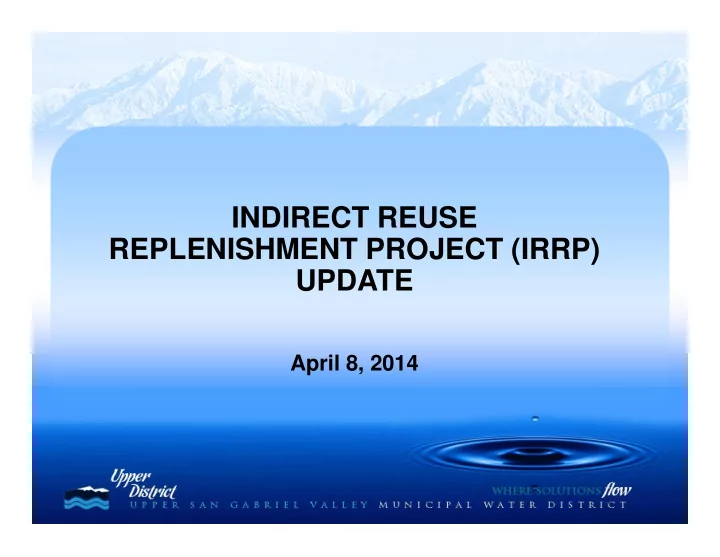

INDIRECT REUSE REPLENISHMENT PROJECT (IRRP) UPDATE April 8, 2014
Upper District • A special district formed in 1960 • 144 square mile service area • Population served: 900,000 • Provides supplemental water to San Gabriel Valley communities • Metropolitan Water District member agency • Total water demand is about 200,000 acre feet of water annually. • 2013/14 Budget $32.1 million Division 4 Division 5 Division 3 Division 1 Division 2 Director Director Director Ed Director Dr. Director Michael Bryan Urias Chavez Anthony Charles M. Touhey R. Fellow Treviño www.usgvmwd.org
California’s Current Drought � Governor’s emergency declaration � 0% State Water Project Allocation � $1,300 per AF + spot market water transfer prices (typical dry-year price is $300 - $350 per AF) � 17 communities without water in 60 days or less
Project History: Motivation 4
Renewed Interest ��������������������� 250,000 �������������������� 225,000 200,000 Expected to occur �������� ������� �������� 1 in 10 years 175,000 150,000 Acre-Feet 125,000 Allocated MWD Firm Supply 100,000 Existing Recycled Water 75,000 Surface Water (dry year) 50,000 Groundwater w/o 25,000 replenishment 0 Dem&s Existing Supplies 5
Past Efforts 1991: San Gabriel Valley Water Reclamation Program (16,000 AFY) 1996: San Gabriel Valley Recycled Water Demo Project (8,100 AFY) 2008: Groundwater Reliability Improvement Project (GRIP) (25,000 AFY) 6
Alternatives Unit Costs May 2013 $146M $100M $62M
Groundwater Recharge with Recycled Water - “Indirect Reuse” � Current widespread practice � Lower San Gabriel River � Orange County � San Bernardino County � 3.3 billion gallons per year (20,000) households) � 8 miles of > 36” diameter pipeline � Pump station 8
Identified Spreading Location 9
Developed Project Boundary • Completed Extensive Groundwater Modeling • Tentative Regulatory Acceptance • Travel time and boundary defined 10
Treatment Optimization Bench-scale Ozone System
Project Research Grants � Since December 2011, Upper District was selected by WateReuse Research Foundation, USBR, and MWD to perform Pilot Level Testing of Advanced Treatment Technologies: � WRRF/USBR = $375K Ozone Treatment Pilot � WRRF = $150K for Soil Aquifer Treatment Pilot � MWD FAF = $150K BAC Treatment Pilot � Suppliers and other agencies = $700K for Advanced Treatment Pilot Research 12
Treatment Optimization � Total research = $1.4M to test advanced water technologies including Ozone, BAC, UV and SAT � Upper District benefits: � Demonstrate proposed advanced treatment technologies and advance regulatory review by CADPH and Regional Board � Research will help enhance project cost estimates � Nationally accepted pilot and research program with CADPH participating every step of the way 13
Advanced Treatment Pilot Plant BAC MF Ozone
Advanced Treatment Pilot Plant New Ozone Equip.
Advanced Treatment Pilot Plant Ozone Unit
Advanced Treatment Pilot Plant RO Unit
Available Diluent Water 18
Preliminary Pilot Research Results � Ozone and BAC pilot results show that most CEC’s are eliminated while reducing TOC by 30 – 40% Full-Scale Ozone Generator Full-Scale BAC 19 Filter
Cl 2 O 3 SAT Pilot Research � Research Initiated in September 2013 to Study the natural occurring Soil Aquifer Treatment (SAT) process (WRRF 12-12) � Benefits of the SAT pilot work: C1 C2 C4 C3 � Establish removal of CECs that should occur in the natural environment for regulators and permitting � Establish removal of key pathogens that may be of concern for drinking water wells that are close to project boundary � Demonstrate effectiveness of ozone versus chlorine to remove additional TOC in natural environment 20
2014 Revised Project Schedule �������������������������������� ��� 2011 2012 2013 2014 2015 2016 2017 2018 Immediate Work Tasks Task 1 Agency Coordination Task 2 Land And Right of Way Requirements Task 3 Regulatory Compliance Task 4 Optimization of Treatment Technologies Task 5 Project Cost Estimate Task 6 Funding Plan Task 7 Preliminary Project Report Project Completion Work Tasks Task 8 Public Outreach Task 9 Finalize Funding Plan Task 10 Update Environmental (CEQA/NEPA) Task 11 CDPH / RWQCB Approval (Engineer's Report) Task 12 Obtain Right of Way Task 13 Update Design Task 14 Bid Project Task 15 Construction Task 16 Operations Blue bars represent current schedule for approved tasks. Green bars represent future tasks and are tetatively scheduled to begin not sooner than indicated. 21
Diversified Portfolio of Sustainable Water Supplies Recycled water is 1/3 of our ability to reduce exposure to imported water risks! The Water Bond is needed to triple the use of Recycled water by 2018!
QUESTIONS? 23
Recommend
More recommend